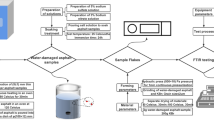Abstract
Understanding the properties of bitumen and its interaction with mineral aggregates is crucial for future strategies to improve roads and highways. Knowledge of basic molecular and electronic structures of bitumen, one out of the two main components of asphalt, poses a major step towards achieving such a goal. In the present work we employ atomistic simulation techniques to study the interaction of asphaltenes, a major constituent of bitumen, with quartz surfaces. As an effective means to tune adhesion or cohesion properties of asphaltenes and mineral surfaces, we propose chemical modification of the pristine asphaltene structure. By the choice of substituent and site of substitution we find that adhesion between the asphaltene molecule and the quartz surface can easily be improved at the same time as the cohesive interaction between the asphaltene units is reduced, while other substituents may lead to the opposite effect. We also provide insight at the molecular level into how water molecules affect interactions between asphaltenes and quartz. Our approach emphasizes a future role for advanced atomistic modeling to understand the properties of bitumen and suggest further improvements.






Similar content being viewed by others
References
Wiehe A, Liang KS (1996) Asphaltenes, resin, and other petroleum macromolecules. Fluid Phase Equilib 117:201–210
Barth EJ (1962) Asphalt, science and technology. Gordon and Breach, New York
Rostler FS, Whiteoak D (2003) The shell bitumen handbook, 5th edn. Shell UK Oil Products Limited, London
Corbett LW (1969) Composition of asphalt based on generic fractionation using solvent deasphalting, elution-adsorption chromatography, and densimetric characterization. Anal Chem 41:576
Sheu EY, Mullins OC (1995) Asphaltenes: fundamentals and applications. Plenum Press, New York
Yen TF, Chilingarian GV (1994) Asphaltenes and asphalts. Elsevier, Amsterdam
Eberhardsteiner L, Fu J, Hofko B, Handle F, Hospodka M, Blab R, Grothe H (2015) Influence of asphaltene content on mechanical bitumen behavior: experimental investigation and micromechanical modeling. Mater Struct. doi:10.1617/s11527-014-0383-7
Greenfield ML (2011) Molecular modeling and simulation of asphaltenes and bituminous materials. Int J Pavement Eng 12(4):325–341
Zhang L, Greenfield ML (2007) Analyzing properties of model asphalts using molecular simulation. Energy Fuels 21:1712–1716
Zhang L, Greenfield ML (2007) Molecular orientation in model asphalts using molecular simulation. Energy Fuels 21:1102–1111
Zhang L, Greenfield ML (2007) Relaxation time, diffusion, and viscosity analysis of model asphalt systems using molecular simulation. J Chem Phys 127:194502
Li DD, Greenfield ML (2014) Viscosity, relaxation time, and dynamics within a model asphalt of larger molecules. J Chem Phys 140:034507
Zhang L, Greenfield ML (2010) Rotational relaxation times of individual compounds within simulations of molecular asphalt models. J Chem Phys 132:184502
Zhang L, Greenfield ML (2008) Effect of polymer modification in properties and microstructures of model asphalt systems. Energy Fuels 22:3363–3375
Li DD, Greenfield ML (2014) Chemical compositions of improved model asphalt systems for molecular simulations. Fuel 115:347–356
Li DD, Greenfield ML (2011) High internal energies of proposed asphaltene structures. Energy Fuels 25:3698–3705
Tarefder RA, Arisa I (2011) Molecular dynamic simulations for determining change in thermodynamic properties of asphaltene and resin because of aging. Energy Fuels 25:2211–2222
Hansen JS, Lemarchand CA, Nielsen E, Dyre JC, Schrøder T (2013) Four-component united-atom model of bitumen. J Chem Phys 138:094508
Lemarchand CA, Schrøder TB, Dyre JC, Hansen JS (2013) Cooee bitumen: chemical aging. J Chem Phys 139:124506
Lemarchand CA, Schrøder TB, Dyre JC, Hansen JS (2014) Cooee bitumen. II. Stability of linear asphaltene nanoaggregates. J Chem Phys 141:144308
CP2K version 2.3. the CP2K developers group 2012; http://www.cp2k.org/
VandeVondele J, Hutter J (2003) An efficient orbital transformation method for electronic structure calculations. J Chem Phys 118:4365
VandeVondele J, Krack M, Mohamed F, Parrinello M, Chassaing T, Hutter J (2005) Quickstep: fast and accurate density functional calculations using a mixed Gaussian and plane waves approach. Comp Phys Commun 167:103
Krack M (2005) Pseudopotentials for H to Kr optimized for gradient-corrected exchange-correlation functionals. Theo Chem Acc 114:145–152
VandeVondele J, Hutter J (2007) Gaussian basis sets for accurate calculations on molecular systems in gas and condensed phases. J Chem Phys 127:114105
Frisch MJ et al (2009) Gaussian 09, revision A.02. Gaussian, Inc, Wallingford
Case DA, Darden TA, Cheatham TE, Simmerling CL, Wang J, Duke RE, Luo R, Walker RC, Zhang W, Merz KM, Roberts B, Hayik S, Roitberg A, Seabra G, Swails J, Götz AW, Kolossváry I, Wong KF, Paesani F, Vanicek J, Wolf RM, Liu J, Wu X, Brozell SR, Steinbrecher T, Gohlke H, Cai Q, Ye X, Wang J, Hsieh MJ, Cui G, Roe DR, Mathews DH, Seetin MG, Salomon-Ferrer R, Sagui C, Babin V, Luchko T, Gusarov S, Kovalenko A, Kollman PA. AMBER 12 2012; University of California, San Francisco
Wang J, Wolf R, Caldwell J, Kollman P, Case DA (2004) Development and testing of a general AMBER force field. J Comput Chem 34:1157–1174
Sieffert N, Wipff G (2008) Ordering of imidazolium-based ionic liquids at the α-quartz (001) surface: a molecular dynamics study. J Phys Chem C 112:19590–19603
Joule J, Mills K (2010) Heterocyclic chemistry, 5th edn. Wiley, New York
Acknowledgements
We acknowledge Dr. Yaoquan Tu for helpful advice and discussions. This work was supported by a grant from the Swedish Infrastructure Committee (SNIC) for the project “Multiphysics Modeling of Molecular Materials”, SNIC2013-26-31.
Author information
Authors and Affiliations
Corresponding author
Rights and permissions
About this article
Cite this article
Jena, N.K., Lyne, Å.L., Arul Murugan, N. et al. Atomic level simulations of the interaction of asphaltene with quartz surfaces: role of chemical modifications and aqueous environment. Mater Struct 50, 99 (2017). https://doi.org/10.1617/s11527-016-0880-y
Received:
Accepted:
Published:
DOI: https://doi.org/10.1617/s11527-016-0880-y




